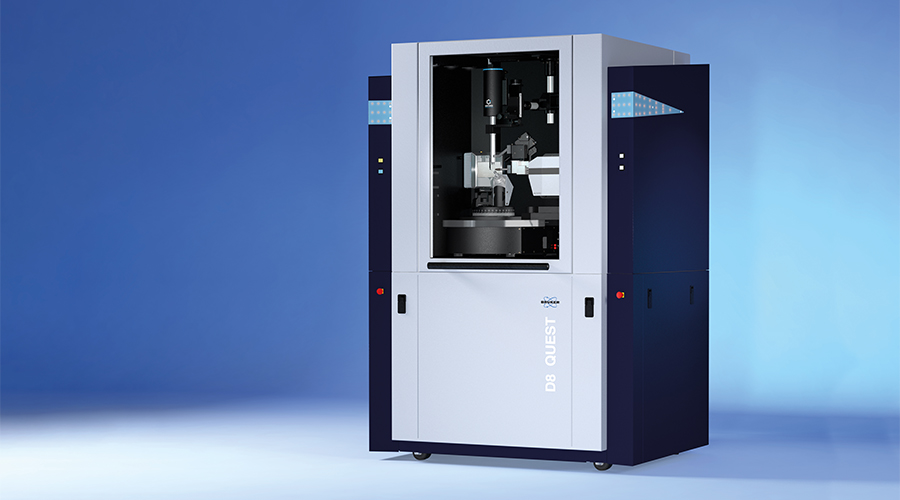Solid State Chemistry
Solid state chemistry: the state of things
Understanding structure-property relationships of solids and applying the wide spectrum of tools chemistry can offer to improve the solids’ properties are often at the heart of a solid-state chemist’s work. Frequently, investigations involve non-ambient conditions, e. g. with respect to temperature and pressure. Bruker’s instruments feature easy-to-use toolkits for ambient and non-ambient investigations. Our solutions are providing the insights scientist need to develop materials with higher efficiency and a lower consumption of global resources.
Single Crystal XRD in Solid State Chemistry
Single crystal X-ray diffraction delivers a detailed picture of the three-dimensional arrangement of atoms in the sample. A variety of non-ambient temperature and non-ambient pressure attachments are integrated to our solutions. Modern software tools facilitate the investigation of challenging samples, such as twinned crystals, modulated structures, and deformed crystals.
Structures determination of inverse perovskites supports
A series of inverse perovskites, M3TtOIn has been investigated by Single Crystal X-ray Diffraction between 50K and 500 K. The paper provides structural details which have found great interest in 3D-Dirac material research.
Vibrational Spectroscopy in Solid State Chemistry
FT-IR spectroscopy can help solid state chemists to understand reactions on surfaces. Comparing the well-understood single crystal reference system and the powdered particles allows to investigate the role vacancies for the absorption of chemicals. Form the presence of absorption bands qualitative structural information can be deducted and quantitatively evaluated. Here are some Highlights.
Understanding Reactions on Catalytic Oxide Powders
FT-IR spectroscopy can help understand catalytic reactions on surfaces by comparing the well-understood single crystal reference system and the powdered particles. In this example, the defect sites of rutile TiO2 (r-TiO2) were probed to assess the density of O vacancies and to demonstrate the role of O vacancies for the surface chemistry of formaldehyde on TiO2. This research on solid state catalysts was performed on vacuum FT-IR spectrometers adapted on UHV (ultra-high vacuum) reaction chamber.
Left: IRRAS data for CO adsorbed on perfect and reduced r-TiO2 single-crystal surface at 110 K.
Excitation studies of metal complexes in solid state
Transmission FT-IR provides detailed insights into the distribution of charges in excited state systems of metal complexes. It helps assess the kinetics of their decay by measuring the differences in ground- and excited-state vibrational frequencies for IR chromophores and by recording the temporal evolution of those transient spectral features. On the right, the time-resolved decay of the excited state is shown. Using Bruker research spectrometers featuring Step-Scan option, nano-second time resolution is accessible.
Monoexponential (A) and biexponential (B) fits to the integrated intensity of the excited-state ester CO band of 1 as a function of time.
Solid state reaction characterization by Raman microscopy
The quick characterization of freshly prepared, potentially air or moisture sensitive compounds can prove a challenge. This holds particularly for solid state reactions carried out under high temperatures in glass or other transparent ampoules.
Raman microscopy measures through these transparent materials and delivers structural information in a few minutes, much faster than many other methods. Images obtained allow a detailed assessment of the identity of the synthesized material shortly after the preparation. Raman microscopy is an ideal tool to identify samples for further analytical investigations, such as XRD, time efficient and with little effort.
Red crystal in glass tube to be analyzed with Raman spectroscopy. Image courtes yof Dr. Adrian Geyer, University of Stuttgart.
NMR Spectroscopy in Solid State Chemistry
Nuclear magnetic resonance (NMR) spectroscopy is a powerful and versatile analytical tool used in solid state chemistry to investigate the structures and properties of solids. ceramics, catalysts, zeolites, and minerals are materials that are usually not soluble and lend themselves for solid state NMR applications. It is highly complementary to a X-ray techniques such as powder or single crystal diffraction.
Solid State NMR
Solid state NMR can provide information on the local electronic and geometric environments of atoms, hence the term NMR-crystallography has been used. NMR can also determine the interactions between different molecules in a solid. This information can help elucidate the structure, dynamics, and reactivity of materials, making solid state NMR a valuable tool in the design and optimization of new materials for a range of applications.



